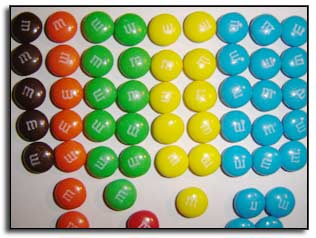 |

Distrust of proper strawberry flavored Mentos™ distribution led to the first experiment and the creation of the webzine Scientific AmeriKen. In the experiment, Mentos™ were shown to be in proper ratio of 1 Orange, 1 Yellow, 1 Pink (Mentos Ratios). Nearly 10 years later, Scientific Ameriken revisits the issues surrounding candy distributions as it peers into differences between Skittles™ and M&Ms™.
Both Skittles and M&Ms have long been the focus of scientific statistical analysis as they both contain a large number of randomly assorted colors. Scientific AmeriKen hopes to push this research to a new level and explore a fundamental difference between Skittles and M&M's. Although the candies share similar colors (M&Ms have 1 extra color), the fact that all M&Ms have the same flavor and Skittles have assorted flavors may influence the distribution of colors. Therefore the hypothesis of this experiment is that M&Ms will have random distribution and Skittles will have a skewed distribution. Reasoning for this hypothesis is based on the fact that green Skittles simply taste awful and it would be unwise for Skittles to drive away customers by overfilling packs with these monstrosities.

Many experiments have studied M&Ms and Skittles and their procedures described:
Skittles & M&Ms Probability Experiment
The Statistics of M&Ms
Graphing Colorful M&Ms
 Procedures for this experiment are similar. Candies are removed from packs and counted. 10 Packs for Skittles and 10 packs for M&Ms. Totals for each color are divided by total for each pack to determine color percentage per pack. Means and standard deviations are then derived for each color and compared.
Procedures for this experiment are similar. Candies are removed from packs and counted. 10 Packs for Skittles and 10 packs for M&Ms. Totals for each color are divided by total for each pack to determine color percentage per pack. Means and standard deviations are then derived for each color and compared.
Introduction & Materials and Methods | Results | Discussion | Additional Information
|
 |




 Procedures for this experiment are similar. Candies are removed from packs and counted. 10 Packs for Skittles and 10 packs for M&Ms. Totals for each color are divided by total for each pack to determine color percentage per pack. Means and standard deviations are then derived for each color and compared.
Procedures for this experiment are similar. Candies are removed from packs and counted. 10 Packs for Skittles and 10 packs for M&Ms. Totals for each color are divided by total for each pack to determine color percentage per pack. Means and standard deviations are then derived for each color and compared.